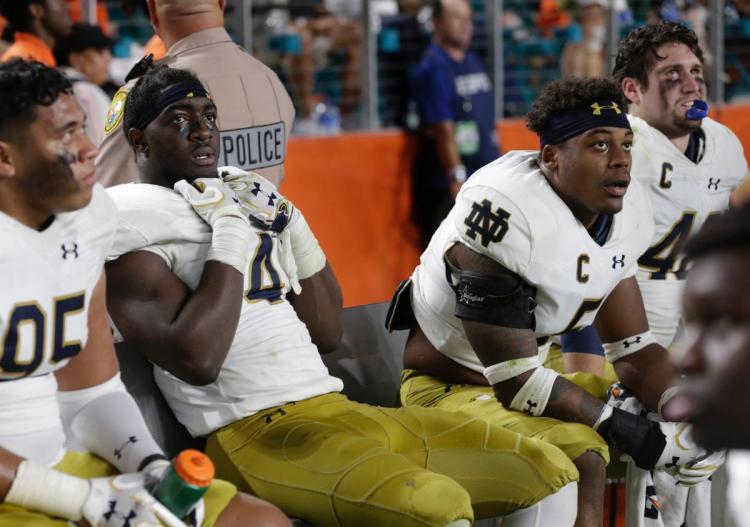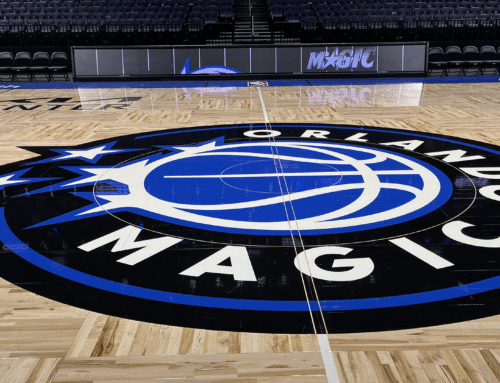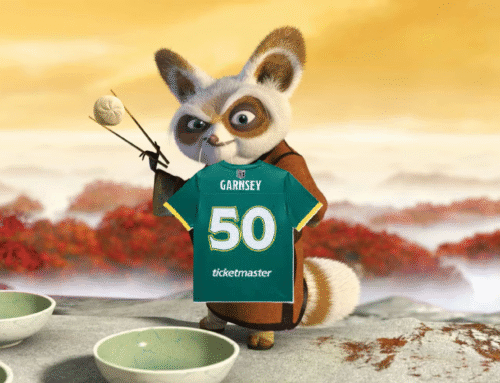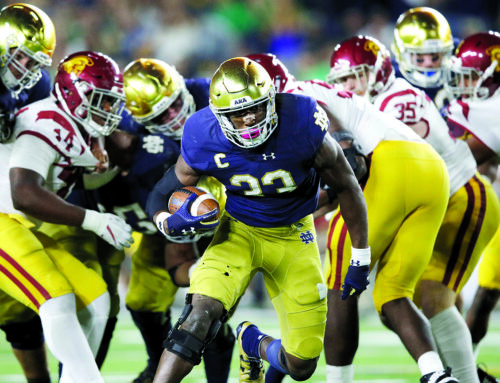Everything went wrong, but let’s power through to look at which advanced stats were bad, ugly, and terrible in Notre Dame’s loss to Miami. And instead of previewing Navy, who looks like a usual Midshipman team in advanced and traditional stats, let’s look at the validity of some hot takes from the blowout loss.
The Basics

Total yardage isn’t indicative of the difference between the performance on Saturday, but scoring opportunities certainly is. Notre Dame had just two scoring opportunities with first downs inside the Miami 40, a season low by far (there were six such chances against UGA). I wasn’t expecting this game to get into garbage time, and certainly not in the first half. But by both objective and subjective measures it feels like a pretty clear cutoff, with garbage time starting with Miami’s pick-six to make it 27-0 shortly before halftime. As a result, 44% of plays classify as garbage time.
Well, that was gross, and a good lesson in the unpredictability of college football. Nothing Miami or Notre Dame had done this season foreshadowed another massacre in Hard Rock Stadium. Yet that was exactly what unfolded, with the Canes dominating in every facet of the game. The Irish had everything click in a few big wins this season, and this was the inverse of the Michigan State, USC, and NC State games. Some days you are the windshield, some days you’re the bug.
Explosiveness

The Irish seemed to have a big-play advantage entering this game against an aggressive Miami defense that was boom or bust, with lots of TFL but also long runs surrendered. That didn’t happen, with zero runs of 12+ yards before garbage time for Notre Dame and just two explosive pass plays. The ND offensive line was dominated and Brandon Wimbush played poorly – the two pieces I’d argue are most critical to the Irish in winning this game. It’s bizarre to me that the Notre Dame rushing attack has been virtually unstoppable in eight wins and complete bottled up in two losses with seemingly no middle ground, but here we are.
Nothing worked offensively. The coaching was bad, the execution was poor, and things snowballed very quickly in a hostile environment. Monday morning quarterbacking a blowout loss is the easiest of things, because we all watched nothing succeed and our minds immediately fill with infinite possibilities of things that at least have the possibility of breaking through. But to pinpoint one area – passing, blocking, play-calling – is impossible in a thorough beating like this.
The best one can do for optimism is to point out that after a somewhat similar but less extreme struggle against Georgia, the offense rebounded pretty well. Just as young defensive backs struggled immensely last year and vastly improved in 2017 in part because of that experience, we can hope that these hardships do the same for Wimbush and many young offensive players.
Efficiency

This game reiterated an obvious point Irish fans hoped didn’t apply to the 2017 team: you cannot be a great team without balance. The Notre Dame passing game looked inconsistent all year – some games flashing immense promise, and in others floundering for quarters at a time (or games against tough defenses). In two games now we’ve seen what a strong defense can do to an imbalanced offense – shut down the run and Chip Long’s offense to play left-handed and throw to win.
It’s sad because the playoff potential was/maybe still is there. If you Frankenstein the pieces of this offense and defense all firing together on all cylinders at the same time – Wimbush’s MSU or Wake Forest passing with the run game against USC and defense against NC State, let’s say – it’s a playoff team. Unfortunately that consistent excellence has eluded this team, and on Saturday is was a domino effect with failure in one area begetting more bad things.

The defensive performance was one example of that ripple effect. They put on a poor but not as miserable performance as the offense, and were constantly put in poor field positions due to turnovers and offensive ineptitude. The Canes averaged about 30 yards per possession – an average number – yet were gifted an average starting field position of their own 43 yard line. It’s hard to bend but don’t break when there’s no room to bend.
That’s not to minimize the poor things displayed on Saturday. The honeymoon period with Mike Elko on message boards and beyond probably ended over the last two weeks, cemented by Malik Rosier draws up the middle. The Irish linebackers had a particularly poor game, exploited in pass coverage and slow to diagnose and react to runs. It’s a unit that is still much improved, but has dropped from a top-10 to 15 defense in S&P+ to just top-25ish after the last two weeks.
Finishing Scoring Opportunities, Field Position, and Turnovers
The turnovers and field position went hand in hand in this game – Miami’s average starting field position was an incredible 23 yards better than Notre Dame’s (starting at their own 20). Looking at historical data, teams that have an advantage of 20+ yards in average starting field position win 97% of the time and on average outscore their opponents by 32 points. Hey, that matches up eerily well to Saturday’s game!

It could have been even worse, somehow, because the Irish defense did stiffen up and hold the Hurricanes offense to a few field goals (and a miss) when some of the four Notre Dame turnovers had given Miami generous field position. About the only upside is that the Irish scoring eight points in their one red zone trip will bump up their average points per visit – hurray!
The Irish could not afford to lose the turnover battle (or really, any of the five factors categories) and expect to win without countering with dominance in another area. That, uh, didn’t happen. By the advanced stats the Canes did get some turnover luck in this one, but they also created those opportunities pretty systematically with a ton of pressure/sacks and pass deflections. In all of our misery it’s worth acknowledging just how well Miami executed – virtually mistake and penalty free (as called), with strong efficiency and explosiveness numbers across the board.
On to Navy the Big Picture
The hot take machines started firing up around eight minutes into last Saturday’s action, so let’s take a minute to reflect on the big picture here:
The Notre Dame gameplan was horrible, BK defaults back to the pass: After the first quarter I saw lots of stats thrown out already about run/pass splits, but there’s not a huge difference (in very small sample sizes) between the start of the Miami game and USC or NC State, which most folks seemed fine with. The game plan obviously bombed, but assuming that going run-heavy or that different types of runs would have done the job is some confirmation bias at its best.
Notre Dame always no–shows in big games: There are definitely some high profile defeats in recent program history – 2012 Alabama, a beating at USC during the late 2014 collapse, and all of the 2006 losses if you want to go back that far. But generally the Kelly era has been characterized by close, heartbreaking losses – both to teams that shouldn’t be close and coming up just short in the big-game showdowns like Clemson, FSU, Stanford 2015, or UGA earlier this year. This type of beat down hasn’t been common over the last eight years, although that doesn’t make it sting any less.
This shows how far away Notre Dame is from competing for a national title: This one has some truth in it – great teams don’t get blown out. On the always excellent Rakes Report last week, Chris Wilson and Brian Fremeau (creator of FEI) talked about how top-5 teams consistently put up huge average margins of victory. These margins come from both blowing out a lot of teams and not losing by much when they lose. Strangely, this season has included both blowouts of bad and good teams (a great sign) and now a blowout loss on the road (a bad sign).
Recent history though, doesn’t suggest that means you are a galaxy away from playoff contention. UGA is clearly very good and everything went off the rails at Auburn last week – no one is piling dirt on the Bulldog and Kirby Smart’s grave (yet). Ohio State has been a top-3 program since Urban Meyer’s arrival, but somehow got housed in Iowa City a few weeks ago (somehow allowing Iowa to put up 55 with the 108th ranked offense in S&P+ against the #14 Buckeye defense). They also lost 31-0 to Clemson on the biggest of stages, the CFP, to close 2016.
Oklahoma was rolled at home last season by Ohio State, and they’ve bounced back nicely. Dabo Swinney’s magical run at Clemson was preceded by a 51-14 loss at home to FSU in a top-5 matchup in 2013. Bad matchups happen, things can snowball, and confidence and mental focus can plummet off a cliff with 18-22 year old college athletes. It doesn’t necessarily spell doom to a bounce-back season, just playoff hopes.
Fire Kelly! This one isn’t as common, but it could grow with a struggle in either of the last two games. Along with the early success of 2017 came the slow creep of increasing expectations, so it’s helpful to remember what most fans thought a good season would look like before demolitions of a few rivals and a close loss to a very good SEC team. In this piece before the season I looked at the program quality and W-L record for Brian Kelly, and came to the following conclusion:
“After finishing 29thin F+ last season, combined with performances below the top-25 level in three of the past four years, Kelly needs to show strong improvement to argue he’s made changes that are correcting the program’s course back to a top 10 (or near) level. A top 10-15 performance would represent a step in the right direction, and unless lightning strikes twice, will lead to enough wins that Kelly should be back. Any worse than top-15 in program quality, and that’s where lucky with wins and losses will determine Kelly’s fate.”
As of today, the Irish remain a top-15 and borderline top-10 team, per both human polls and advanced stats systems like S&P+, FEI, and Massey-Peabody. It’s been a strong bounce-back season from 4-8 and a finish of 29th in F/+ so far, with both coordinator hires looking like upgrades, although it will take time to see to what magnitude Long and Elko can elevate the program. There’s still two games left for things to change – a slide to 8-4 would put the hot-seat conversation back in play, or a 10-2 finish with a major bowl win could continue the momentum that has been building (with some setbacks) in 2017.
There’s still reasonable arguments you can make on two sides of the debate – one would be that this could be Kelly’s fourth top-10 caliber team in eight seasons, which is far better than any recent predecessor and hardly justifies a coaching change (which even at powerhouse schools, history would suggest are mostly crapshoots). On the other hand, you could argue that Kelly has failed to field a top-5 team now in eight seasons (or arguably one), and that ceiling isn’t cutting it.





Thanks Michael, especially the thoughts on the Big Picture. As disgusting and embarrassing as Saturday night was, two more victories and a good showing in a NY6 Bowl would make for a great season.
Agree and also thanks. This was informative and focused. Helped somehow to ease the sting.
It was hard to find the courage to read, but your writing helped me make it through. A couple of thoughts:
1. You’re totally right about the passing consistency. There were a lot of open receivers in the first half – something that hasn’t happened all year – and Wimbush couldn’t convert. I’m not saying the protection was great, but an elite (or say, top 20) passing QB could have made hay. Hopefully the weak upward trend in passing continues and next year we can better handle situations like this.
2. Even if this defense just stays at top 25, we should be okay. However, we actually have some chances to look better against Navy this week (they’re having a down year and we’re tougher than their average competition, so should boost our advanced stats), if only Elko can somehow not give me a heart attack like Diaco and BVG.
3. On Kelly and the staff – I think this was a fine gameplan and Wimbush couldn’t pass and then stuff snowballed. It sucked to watch but was actually less painful than some close losses I’ve seen (though a blowout is a worse sign). Here are some questions I would ask:
a. Can we get back to back 10 win seasons? That would be impressive if we did it this year and next year, especially considering the changing of the guard on the line.
b. Can we finish the season with a top 15 defense? I know our talent – though in the top 10 – is more skewed to offense, but can we get elite defensive play consistently? This seems so dependent on a few super stars, and I’m hoping that Elko’s success will unlock some big recruits. Is there any evidence of that?
c. Can Wimbush finish next year with ~57% completion? This would be a big jump, but with some modest improvements in him and the receiving corp, it does not strike me as out of the question. If so, I think this can be an elite offense, as we can run him less (and in more back-breaking circumstances).
What do people here think?
I’ll throw my thoughts out there:
1) It definitely should be the goal in my opinion. I’d ballpark that we will enter 2018 projected to be a top 10-15ish team with the number of returning players, although there are always unexpected losses to injury/transfer/draft. With that I’m guessing our over/under and most likely win projection from advanced stats will be 9 wins, due to the SOS. Michigan, USC, Stanford, FSU, and Virginia Tech will all be projected top-20ish teams as well. Throw in other teams that aren’t slouches – Wake, Northwestern, Syracuse, Navy – and it looks challenging but achievable if key players keep developing.
2) There are definitely some very solid defensive recruits, although there are still some holes to fill. I think we can definitely be a top-15 defense next year with so many starters returning, although I think Tillery and Tranquill could take long looks at the NFL. But Year 2 in Elko’s defense should be really promising IMO with lots of young talent already contributing to this defense as sophomores and freshmen.
3) It will be really interesting to see how the offense looks in ’18. Wimbush definitely has the potential to become much more accurate and make a jump in his second year as a starter. What do BK and Long want the offense to look like? How effective will the O-Line be without Glinch/Nelson? I think the assumption is that the success this year and talent on the OL, although it will be less seasoned/proven, would still lend itself to a run-first attack, but history has shown that BK tends to throw more with more experienced QBs.
(a) Back to back 10 win seasons would be nice, but I still am not convinced that 10 wins will happen this year. Stanford is always tough, plus playing them the week after Navy AND on the road lowers the odds of victory. As stated in another comment section, we don’t know who ND will face in a bowl game – it could be a team like tOSU, Clemson, or Oklahoma. As for next year, I am optimistic that we will see improvement all around, as long as the new O-linemen can do well.
(b) I think the defense rating will depend on 2 things – can Elko stop the Navy option, and who does ND play in the bowl game? One thing about defense is that while you need a decent scheme (i.e., one not designed by BVG), you really really really need athletes – ND needs more athletes on D.
(c) I think that we will see small improvements in Wimbush’s accuracy, but reading a lot of scout comments about QBs transitioning to the NFL and many of them seem to think that if a QB is inaccurate, they will likely continue to be inaccurate.
It’s not a guarantee to get to 10 this year, but if we lose to Stanford we are heading to a lesser bowl game we probably have a better chance of winning.
I still think they can beat a top ten team. I know, stupid optimism right? But I have seen this team perform at a very high level this season. I guess I would like to see them square up with a top team in a big bowl game just so we can see how good they really are. I’m guessing most on this site have concluded they aren’t elite and will get beat down by an elite team.
I’m not writing them off against a top-10 team. But what we’ve seen in a limited sample size is that a really talented defense (like say, Ohio State or Auburn) can make sledding difficult for this offense if our OL isn’t dominating in the trenches. So I think there are certain matchups there where I would feel much better than others, and also I’m confident that we wouldn’t see that type of defense in the hypothetical situation where we lose to Stanford.
What makes you think that they can beat a top 10 team? That has almost never happened in Kelly’s tenure at ND. We beat #8 OU in Norman (finished #11) and #17 Stanford in SB (finished #7) in 2012. Also beat MSU in 2013, who finished ranked #3 but was unranked when we played them. All other games against top 10 teams, either at the time of the game or end of season, have been losses. He doesn’t get his team ready for big games, for whatever reason. If we were to beat a good team in say the Cotton Bowl this year, it would probably be the best win in his entire career. Not to say it’s impossible, but it would be a deviation from the standard.
I feel like there’s a more recent example, too… What was it… Oh yes. It was a little less than a month ago, when we pummeled then #12 and current #11 USC. There’s a decent chance they’ll end up in the top ten at the end of the season. Facing then-#13 NC State the next week was no small emotional challenge, and we manhandled them. As for past seasons, we also hammered 2011 MSU 31-13; they finished #10 in the Coaches Poll and #11 in the AP, and were #15 in the AP at the time of the game.
I agree that Kelly’s record against top ten teams is not up to par. But to say he “doesn’t get the team up for big games”… We have those elite wins over USC, Oklahoma, Stanford, and MSU (twice). We lost to end-of-season #5 2014 Florida State, #2 2015 Clemson, #3 2015 Stanford, #12 2011 Michigan, and current #7 Georgia by a COMBINED 14 points. We also lost comfortably to end of season #4 2010 Stanford, #7 2011 Stanford, #6 2011 USC, #6 2013 Oklahoma, and #4 2015 Ohio State when were overmatched.
We came out flat against then-#2 2012 Alabama, #11 2014 ASU, and #7 2017 Miami, and got killed. Those were crappy games that absolutely deserve to count against Kelly, but I think there’s a tendency to forget the times that we’ve taken an elite team down to the wire and to brush aside the times that we’ve turned in an excellent win against an elite team. Those games don’t support the “can’t get his team ready” idea.
I’m *not* satisfied with the big game record so far. I just don’t think the blanket statement of “can’t get them ready” is justified. If anything it makes the problem even more puzzling, because he clearly has gotten them ready for some big games.
The biggest distinction I can seem to find is that he does pretty well in big games at home, although there are still a few stinkers like USC 2013 and OU 2013 in there. Also, puzzlingly, all (almost all?) of his WTF losses to inferior teams (Tulsa, Navy, Northwestern, USF) have happened at home.
His performances in away and bowl games, though have been pretty abysmal. He seems to always play MSU close, and has had some good wins against good Spartan teams in East Lansing, including this year. “Big stage” away games – NCG, tOSU Fiesta Bowl, Miami, ASU, USC – have had similar storylines. Namely, the team comes out looking overwhelmed and gets swallowed up by the moment. They lose embarassingly as they play from behind, pushing harder and harder, usually resulting in snowballing mistakes. 2014 FSU and 2012 OU are the outliers to this pattern. Even 2015 Clemson the team came out looking tight and overwhelmed, but managed to pull it out and play well in the second half.
I don’t know what the apparent mental block is in big games away from ND stadium, but to say “I still think we can beat a top 10 team in a bowl game” is contradictory to historical performances. True that there have been signs of a big turnaround this year, but the team that was barely there last Saturday is so far from the team that pummeled USC, that I’m not even sure what to make of it.
The last five quarters of football that ND has played have been poor. I just want to see ND come out and play aggressive, fundamentally sound football at this point. I want to see solid blocking, good run reads, and confident passing. On defense I want good run fits, guys getting off blocks, and solid tackling.
In my opinion, the team has been listening to the hype too much and they let the moment become too big for them. They just need to focus on the play in front of them and winning their individual match up again.
After last year that never was, I can sympathize with the temptation of listening to the hype.